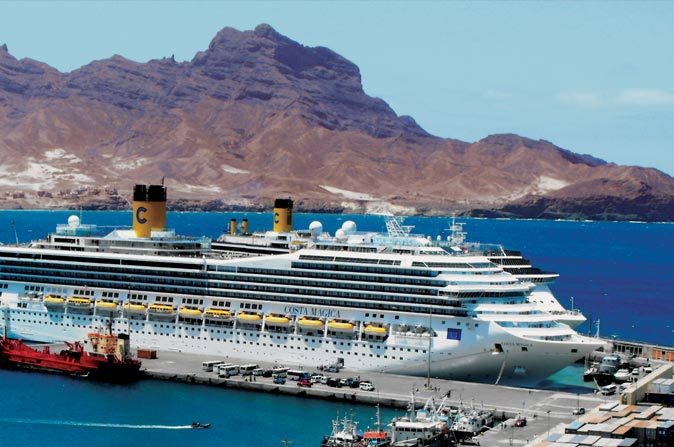Agriculture & Fisheries / Cape Verde
Looking seaward
Porto Grande, the famed port of Sao Vicente island, is spearheading the country’s transformation into a marine hub

Cruise ship Costa Magica docking in Porto Grande while its 3.500 passengers visit Mindelo. Cabe Verde received 54 cruise ships and more than 38.000 passengers in 2013.
Cape Verdeans see the surrounding ocean as a vast economic source of wealth. The sea cluster, supervised by the Ministry of Infrastructures and Marine economy, federates all the related activities ranging from ports, fisheries, ship repair, to transport. In recent years, Cape Verde has invested in expanding and modernising seven of the archipelago’s nine ports. The upgrade of the ports systems has already reduced operating costs by up to 70%.
The cluster has its centre on the island of São Vicente. Porto Grande is the largest port in the country and one of the best in the region in terms of natural conditions. With more than two kilometres of docks, Porto Grande is a major asset to transform Cape Verde into a leading shipping hub for the western coast of Africa.
As part of an overall scheme, valued at around $816 million, the construction of a container terminal is planned in Porto Grande, to supply ships operating between Africa, America and Europe. Occupying 19.4 hectares, the new facility will handle a flow of 1 million twenty-foot equivalent units each year.
Recently the concession to exploit the national shipyard Cabnave, serving fleets operating in the international waters, was given to a Chinese operator. Under the deal, Cabnave should repair annually 10 to 15 times more ships than at present.
Besides, the Netherlands is funding the construction of a cruise terminal in Mindelo. The project, considered strategic to increase the country’s share of this segment of the tourism market, is estimated at about $40 million and the Dutch partner will provide $13.4 million. The remaining funding should be achieved through public-private partnerships.
The cruise terminal will have a quay 250 metres long and 11 metres deep, and train stations and multi-car parks will be built. For its size, the facility will have capacity to receive about 95% of the vessels on Cape Verde’s cruise tourism market. The strategy is to become a regular stop on the route of the cruises and take a bigger share of this juicy market.
Improvements in Praia
The port of Praia, the country’s capital, supplies the entire island of Santiago, home to over half of the Cape Verdean population. Investments here have included the construction of a breakwater to protect the bay from the ‘calema’, a heavy swell that rendered half of the port’s facilities unusable during approximately 10 months of the year. The effects of the improvements are already being felt on the island. Recently, for the first time in the history of the port, three mid-sized cruise ships were docked in Porto da Praia at the same time. The occasion also provided ideal conditions to test coordination between the port and the capital’s airport, and over 1,500 tourists were moved smoothly in just a few hours.
